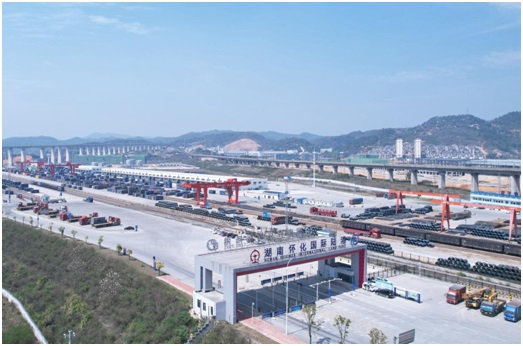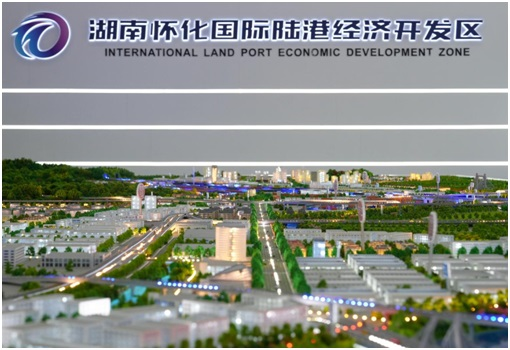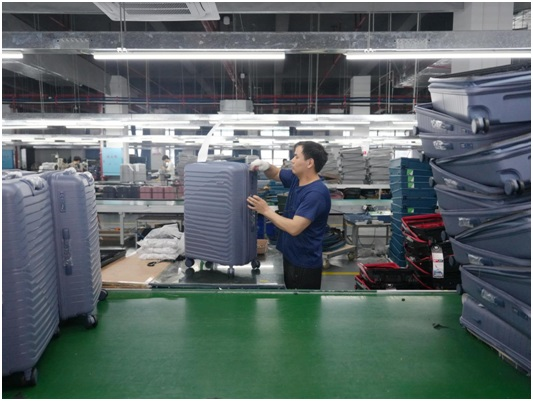KPL
Nestled between the Wuling and Xuefeng mountains in central China, the once-remote city of Huaihua is now emerging as a dynamic gateway to the global economy—thanks to the transformative power of the Regional Comprehensive Economic Partnership (RCEP) and the rise of the Huaihua International Land Port.

Hunan Huaihua International Land Port has opened up seven international logistics channels, including China Laos, China Vietnam, and China Myanmar.
(KPL) Nestled between the Wuling and Xuefeng mountains in central China, the once-remote city of Huaihua is now emerging as a dynamic gateway to the global economy—thanks to the transformative power of the Regional Comprehensive Economic Partnership (RCEP) and the rise of the Huaihua International Land Port.
During a recent visit to the bustling port, gantry cranes hoisted containers with precision while fully loaded freight trains prepared to depart. According to Yang Shijun, General Manager of Huaihua International Land Port Development Co., Ltd., the port’s strategic role has rapidly expanded since RCEP’s implementation in 2022, positioning Huaihua as a critical hub for opening up China’s central and western regions.
From 2022 to 2024, Huaihua’s trade with RCEP countries grew at an average annual rate of 87.23%, topping Hunan Province’s rankings for three straight years. Outbound investment rose even faster, averaging 259.3% growth annually. Huaihua is no longer just a mountain-locked city—it is becoming a “golden bridge” linking inland China with Southeast Asia and beyond.
Huaihua lies at the intersection of key corridors—the New Western Land-Sea Corridor and the Shanghai-Kunming International Trade Corridor—making it a logistical powerhouse. The city connects six major railway lines, facilitating access to coastal ports and ASEAN nations.
Today, the Huaihua International Land Port operates seven international logistics corridors and 161 transport routes—linking to 158 ports and terminals in 52 countries and regions. It is at the core of a new model of openness, based on "dual corridors, two oceans, and dual circulation," aligning seamlessly with China’s national development strategies.

Huaihua promotes the deep integration of port industry and city, breaking through geographical boundaries to achieve two-way cooperation with the world.
The port is continuously upgrading infrastructure, with new logistics centers, container hubs, and enhanced cooperation with neighboring regions to create efficient cargo distribution zones. By 2025, the port aims to handle 10 million tons of cargo, operate 1,200 freight trains, and generate over RMB 100 billion in total port-related output.
Huaihua’s internationalization goes beyond logistics. The city is integrating trade, industry, and urban development to build export-driven industrial clusters tied to RCEP markets. Industries such as luggage manufacturing, traditional Chinese medicine (TCM), bamboo products, and agricultural processing are flourishing.
In just three years, Huaihua’s luggage and leather goods industry has attracted over 150 projects with RMB 10.8 billion in investments. By 2024, output value in this sector is expected to reach RMB 3.012 billion, earning the city a reputation as the “Global Luggage Hub.”
Meanwhile, local specialty agricultural products—once limited by Huaihua’s inland geography—are now reaching international markets via “Huaihua–ASEAN” agricultural express trains. Products such as Huai Orange, Jietan Tea, Xinhuang Yellow Cattle, and Jingzhou Poria are gaining popularity across RCEP countries.

Employees are organizing bags and suitcases in the production workshop of Hunan Outeng Luggage Manufacturing Co., Ltd.
Huaihua is pioneering a new trade model: “ASEAN resources – Huaihua manufacturing – RCEP markets.” This ecosystem of logistics + trade + industry is supported by robust partnerships with ASEAN-based enterprises. From 2022 to 2024, Huaihua’s trade with ASEAN alone surged at an average 164% annual growth rate, with exports led by electronics, bamboo goods, chemicals, fruits, and vegetables.
Xu Zhongjian, Party Secretary of Huaihua, emphasized that the city will fully harness its international land port as a strategic hub, accelerating the development of a commerce- and trade-focused national logistics center. Plans include establishing cross-border e-commerce pilot zones, designated supervision areas, and expanding domestic and international logistics corridors.
“Huaihua’s transformation reflects a clear vision: to become the new engine of growth in central and western China,” said Xu. “We are not just building infrastructure—we are building the future.”
As Huaihua continues its journey from inland heartland to international frontier, it is proving how strategic location, open platforms, and integration with global trade mechanisms like RCEP can reshape the destiny of a city—and a region.
KPL